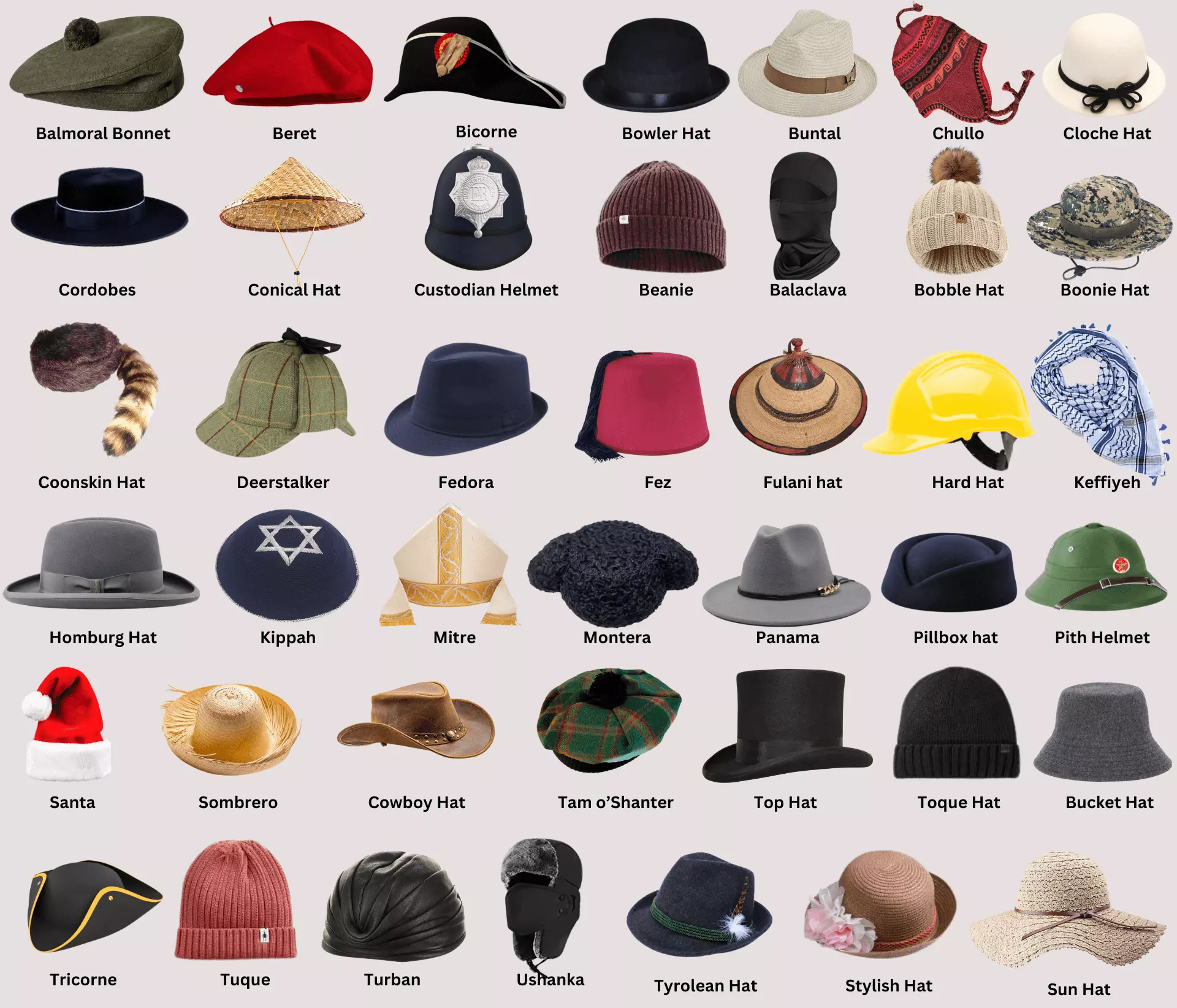Types of hats – Dive into the fascinating world of hats, where form meets function and cultural expression takes center stage. From classic toppers to contemporary designs, hats have adorned heads throughout history, serving practical purposes and making bold fashion statements.
In this comprehensive guide, we explore the diverse array of hat types, uncovering their unique characteristics, materials, and origins. We delve into the functional and aesthetic considerations that shape hat design, analyzing their role in protection, comfort, and personal style.
Overview of Hat Types

Hats, an essential part of human attire, have evolved throughout history, reflecting cultural influences, fashion trends, and personal styles. From classic designs to contemporary creations, the vast array of hat types offers a myriad of options to suit every taste and occasion.
From Panama hats to baseball caps, there’s a hat for every occasion. And if you’re looking for a hat that will make a statement, look no further than the styles worn by Fred Vasseur , the Team Principal of the Alfa Romeo F1 Team.
Vasseur’s signature look includes a variety of hats, from beanies to baseball caps, all of which are sure to turn heads.
Hats serve various purposes, including protection from the elements, personal adornment, and cultural or religious significance. The materials used in hat making range from natural fibers like straw, wool, and cotton to synthetic fabrics like nylon and polyester.
Classic Hat Styles
- Fedora: A soft, felt hat with a creased crown and a brim that can be turned up or down.
- Panama hat: A lightweight, woven hat made from the leaves of the toquilla palm, originating in Ecuador.
- Trilby: A narrow-brimmed hat with a slightly indented crown, often associated with jazz musicians.
- Beret: A round, flat-crowned hat made of wool or other soft material, traditionally worn by French artists and intellectuals.
- Boater: A stiff, flat-crowned hat with a wide brim, popular in the late 19th and early 20th centuries.
Contemporary Hat Designs
- Baseball cap: A casual, visor-brimmed hat often associated with sports and streetwear.
- Bucket hat: A wide-brimmed hat with a soft, foldable crown, popular in the 1990s and early 2000s.
- Beanie: A close-fitting, knitted hat that covers the head and ears, often used for warmth.
- Fascinator: A small, decorative hat or headpiece, often worn at formal events.
- Sun hat: A wide-brimmed hat designed to protect the face and neck from the sun.
Functional and Aesthetic Considerations
Hats serve a variety of practical and aesthetic purposes. They provide protection from the elements, such as sun, rain, wind, and cold. They can also improve comfort by wicking away sweat or providing insulation. Breathability is an important consideration, especially for hats worn during physical activity.
Fashion and Cultural Expression, Types of hats
Beyond their functional benefits, hats have long played a significant role in fashion and cultural expression. They can convey a person’s personal style, social status, or cultural identity. For example, in some cultures, hats are worn to indicate a person’s marital status or religious affiliation.
Historical Significance
Throughout history, hats have been used to convey a wide range of meanings. In ancient Egypt, pharaohs wore elaborate headdresses to symbolize their divine authority. In medieval Europe, knights wore helmets to protect themselves in battle and to display their family crest.
In the 19th century, women wore elaborate bonnets to demonstrate their social status and fashion sense.
Cultural and Historical Perspectives
Hats have played a significant role in human history, reflecting cultural identities, social customs, and aesthetic preferences. Their designs have evolved over time, influenced by cultural and historical contexts.
In ancient Egypt, pharaohs wore elaborate headdresses to symbolize their power and divinity. In the Middle Ages, knights donned helmets for protection in battle, while women wore veils to signify modesty. During the Renaissance, hats became fashion statements, with men sporting feathered berets and women wearing wide-brimmed hats.
Regional Variations
Regional variations in hat styles are often driven by climate, geography, and cultural traditions. In hot, sunny regions like the Middle East, people wear turbans or keffiyehs to protect themselves from the sun. In cold, snowy climates like Russia, fur hats are popular for warmth.
In many Asian cultures, conical hats are worn as a symbol of traditional dress.
Cultural Significance
Hats hold cultural significance in many societies. In religious ceremonies, they may represent reverence or humility. In military uniforms, they denote rank and affiliation. In traditional costumes, they signify cultural identity and heritage.
Concluding Remarks
Hats have transcended mere headwear to become symbols of cultural identity, religious significance, and social status. Throughout history, they have graced the heads of royalty, soldiers, and everyday individuals, reflecting the customs and beliefs of their time.
As we conclude our exploration of hat types, we recognize the enduring appeal of these versatile accessories. Whether worn for practicality, fashion, or cultural expression, hats continue to captivate and inspire, adding a touch of style and individuality to every ensemble.
FAQ Overview: Types Of Hats
What are the most popular hat styles?
Popular hat styles include baseball caps, beanies, fedoras, Panama hats, and cowboy hats.
What materials are hats typically made from?
Hats can be made from a variety of materials, including wool, cotton, straw, leather, and felt.
How do hats reflect cultural identity?
Hats have been used throughout history to represent cultural identity, such as the keffiyeh in Arab culture and the sombrero in Mexican culture.